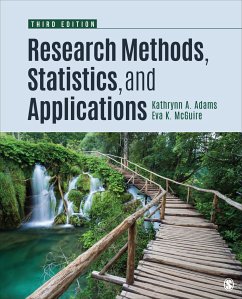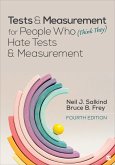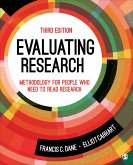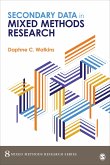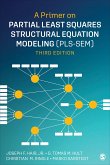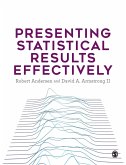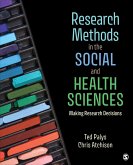- Broschiertes Buch
- Merkliste
- Auf die Merkliste
- Bewerten Bewerten
- Teilen
- Produkt teilen
- Produkterinnerung
- Produkterinnerung
Research Methods, Statistics, and Applications is designed to let students experience being a researcher by integrating research methods and statistics throughout the process. The Third Edition of this best-selling text features new examples, practical applications from across the social and behavioral sciences, and a conversational voice throughout to keep students engaged in the research process.
Andere Kunden interessierten sich auch für
![Tests & Measurement for People Who (Think They) Hate Tests & Measurement Tests & Measurement for People Who (Think They) Hate Tests & Measurement]() Neil J. SalkindTests & Measurement for People Who (Think They) Hate Tests & Measurement96,99 €
Neil J. SalkindTests & Measurement for People Who (Think They) Hate Tests & Measurement96,99 €![Evaluating Research Evaluating Research]() Francis C. DaneEvaluating Research71,99 €
Francis C. DaneEvaluating Research71,99 €![Secondary Data in Mixed Methods Research Secondary Data in Mixed Methods Research]() Daphne C. WatkinsSecondary Data in Mixed Methods Research50,99 €
Daphne C. WatkinsSecondary Data in Mixed Methods Research50,99 €![A Primer on Partial Least Squares Structural Equation Modeling (Pls-Sem) A Primer on Partial Least Squares Structural Equation Modeling (Pls-Sem)]() Joe HairA Primer on Partial Least Squares Structural Equation Modeling (Pls-Sem)50,99 €
Joe HairA Primer on Partial Least Squares Structural Equation Modeling (Pls-Sem)50,99 €![Presenting Statistical Results Effectively Presenting Statistical Results Effectively]() Robert AndersenPresenting Statistical Results Effectively36,99 €
Robert AndersenPresenting Statistical Results Effectively36,99 €![Doing Qualitative Research in a Digital World Doing Qualitative Research in a Digital World]() Trena M. PaulusDoing Qualitative Research in a Digital World70,99 €
Trena M. PaulusDoing Qualitative Research in a Digital World70,99 €![Research Methods in the Social and Health Sciences Research Methods in the Social and Health Sciences]() Ted PalysResearch Methods in the Social and Health Sciences96,99 €
Ted PalysResearch Methods in the Social and Health Sciences96,99 €-
-
-
Research Methods, Statistics, and Applications is designed to let students experience being a researcher by integrating research methods and statistics throughout the process. The Third Edition of this best-selling text features new examples, practical applications from across the social and behavioral sciences, and a conversational voice throughout to keep students engaged in the research process.
Produktdetails
- Produktdetails
- Verlag: Sage Publications
- Artikelnr. des Verlages: 95603680
- 3. Aufl.
- Seitenzahl: 696
- Erscheinungstermin: 3. Februar 2022
- Englisch
- Abmessung: 231mm x 191mm x 25mm
- Gewicht: 946g
- ISBN-13: 9781071817834
- ISBN-10: 1071817833
- Artikelnr.: 62543370
- Herstellerkennzeichnung
- Libri GmbH
- Europaallee 1
- 36244 Bad Hersfeld
- gpsr@libri.de
- Verlag: Sage Publications
- Artikelnr. des Verlages: 95603680
- 3. Aufl.
- Seitenzahl: 696
- Erscheinungstermin: 3. Februar 2022
- Englisch
- Abmessung: 231mm x 191mm x 25mm
- Gewicht: 946g
- ISBN-13: 9781071817834
- ISBN-10: 1071817833
- Artikelnr.: 62543370
- Herstellerkennzeichnung
- Libri GmbH
- Europaallee 1
- 36244 Bad Hersfeld
- gpsr@libri.de
Kathrynn (Kathy) A. Adams earned her PhD in general experimental psychology from the University of Alabama in 1977. She was a Charles A. Dana Professor of Psychology at Guilford College when she retired in 2017 after 37 years of teaching. Her professional interests include gender issues, relationships, and teaching pedagogy. She worked with the Preparing Future Faculty Program for 20 years and helped establish the Early College at Guilford, a nationally ranked high school. In her spare time, she spends as much time as possible outdoors, practices yoga, and bakes chocolate desserts.
Preface
About the Authors
Chapter 1 - Thinking Like a Researcher
Learning Objectives
Critical Thinking
The Scientific Approach
Overview of the Research Process (a.k.a. The Scientific Method)
Thinking Critically About Ethics
The Big Picture: Proof and Progress in Science
Chapter Resources
Chapter 2 - Build a Solid Foundation for Your Study Based on Past Research
Learning Objectives
Types of Sources
Strategies to Identify and Find Past Research
Reading and Evaluating Primary Research Articles
Crediting Sources
The Big Picture: Use the Past to Inform the Present
Chapter Resources
Chapter 3 - Measuring Your Variables
Learning Objectives
Constructs and Operational Definitions
Four Scales of Measurement
Self-Report Measures
Behavioral and Physiological Measures
Archival Research
The Big Picture: How to Choose Measures For Your Study
Chapter Resources
Chapter 4 - The Cornerstones of Good Research: Reliability and Validity
Learning Objectives
Reliability and Validity Defined
Reliability and Validity of Measurement
Assessing Reliability of Measures
Assessing Validity of Measures
Reliability and Validity at the Study Level
The Big Picture: Consistency and Accuracy
Chapter Resources
Chapter 5 - Basics of Research Design: Description and Sampling
Learning Objectives
When is a Descriptive Study Appropriate?
Validity in Descriptive Studies
Defining the Population and Obtaining a Sample
Probability Sampling
Nonprobability Sampling
The Big Picture: Choosing a Sampling Method
Chapter Resources
Chapter 6 - Describing Your Sample
Learning Objectives
Ethical and Practical Issues in Describing Your Sample
Descriptive Statistics
Choosing the Appropriate Descriptive Statistics
Comparing Interval/Ratio Scores with z Scores and Percentiles
The Big Picture: Know Your Data and Your Sample
Chapter Resources
Chapter 7 - Beyond Descriptives: Making Inferences Based On Your Sample
Learning Objectives
Inferential Statistics
Hypothesis Testing
Errors in Hypothesis Testing
Effect Size, Confidence Intervals, and Practical Significance
The Big Picture: Making Sense of Results
Chapter Resources
Chapter 8 - Comparing Your Sample to a Known or Expected Score
Learning Objectives
Choosing the Appropriate Test
One-Sample t Tests
Calculating an Effect Size
Calculating a Confidence Interval
The Big Picture: Examining One Variable at a Time
Chapter Resources
Chapter 9 - Examining Relationships Among Your Variables: Correlational Design
Learning Objectives
Correlational Design
Basic Statistics to Evaluate Correlational Research
Regression
The Big Picture: Correlational Designs Versus Correlational Analyses
Chapter Resources
Chapter 10 - Examining Causality
Learning Objectives
Testing Cause and Effect
Eight Key Threats to Internal Validity
Basic Issues in Designing an Experiment
Validity in Experiments
The Big Picture: Benefits and Limits of Experimental Design
Chapter Resources
Chapter 11 - Independent-Groups Designs
Learning Objectives
Designs with Independent Groups
Designing a Simple Experiment
Analysis of Two Independent-Groups Designs
FORMULAS and CALCULATIONS: Independent-Samples t Test
Using a Data Analysis Program to Calculate Independent Samples t Tests
Designs with More than Two Independent Groups
Analysis of Multiple Independent-Groups Designs
Formulas and Calculations: One-Way Independent-Samples ANOVA
Using a Data Analysis Program to Calculate One-Way Independent-Samples ANOVAs
The Big Picture: Identifying and Analyzing Independent-Groups Designs
Chapter Resources
Chapter 12 - Dependent-Groups Designs
Learning Objectives
Designs with Dependent Groups
Designs with More than two Dependent Groups
Analysis of Dependent Multiple-Groups Designs
Formulas and Calculations: Within-Subjects ANOVA
The Big Picture: Selecting Analyses and Interpreting Results for Dependent-Groups Designs
Chapter Resources
Chapter 13 - Factorial Designs
Learning Objectives
Basic Concepts in Factorial Design
Rationale for Factorial Designs
2 × 2 DESIGNS
Two-Way Between Subjects ANOVA
Beyond the 2 × 2 Independent-Groups Design
The Big Picture: Embracing Complexity
Chapter Resources
Chapter 14 - Nonparametric Statistics
Learning Objectives
Parametric Versus Nonparametric Statistics
Chi-Square Goodness of Fit
Chi-Square Test For Independence
Dependent-Groups Designs with Nominal Outcome Measures
Spearman's Rho to Examine Relationships Between Ordinal (Ranked) Data
Nonparametric Statistics for Independent- and Dependent-Groups Designs with Ordinal Data
The Big Picture: Selecting Parametric Versus Nonparametric Tests
Chapter Resources
Chapter 15 - Focusing on the Individual: Case Studies and Single N Designs
Learning Objectives
Samples Versus Individuals
The Case Study
Qualitative Analyses
Single N Designs
The Big Picture: Choosing Between a Sample, Case Study, or Single N Design
Chapter Resources
Chapter 16 - How to Decide? Choosing a Research Design and Selecting the Correct Analysis
Learning Objectives
Choosing a Research Design
Selecting Your Statistical Analyses
The Big Picture: Beyond This Class
Chapter Resources
Appendix A - Answers to Practice Questions
Appendix B - APA Style and Format Guidelines
Appendix C - Statistical Tables
Appendix D - Statistical Formulas
Glossary
References
Index
About the Authors
Chapter 1 - Thinking Like a Researcher
Learning Objectives
Critical Thinking
The Scientific Approach
Overview of the Research Process (a.k.a. The Scientific Method)
Thinking Critically About Ethics
The Big Picture: Proof and Progress in Science
Chapter Resources
Chapter 2 - Build a Solid Foundation for Your Study Based on Past Research
Learning Objectives
Types of Sources
Strategies to Identify and Find Past Research
Reading and Evaluating Primary Research Articles
Crediting Sources
The Big Picture: Use the Past to Inform the Present
Chapter Resources
Chapter 3 - Measuring Your Variables
Learning Objectives
Constructs and Operational Definitions
Four Scales of Measurement
Self-Report Measures
Behavioral and Physiological Measures
Archival Research
The Big Picture: How to Choose Measures For Your Study
Chapter Resources
Chapter 4 - The Cornerstones of Good Research: Reliability and Validity
Learning Objectives
Reliability and Validity Defined
Reliability and Validity of Measurement
Assessing Reliability of Measures
Assessing Validity of Measures
Reliability and Validity at the Study Level
The Big Picture: Consistency and Accuracy
Chapter Resources
Chapter 5 - Basics of Research Design: Description and Sampling
Learning Objectives
When is a Descriptive Study Appropriate?
Validity in Descriptive Studies
Defining the Population and Obtaining a Sample
Probability Sampling
Nonprobability Sampling
The Big Picture: Choosing a Sampling Method
Chapter Resources
Chapter 6 - Describing Your Sample
Learning Objectives
Ethical and Practical Issues in Describing Your Sample
Descriptive Statistics
Choosing the Appropriate Descriptive Statistics
Comparing Interval/Ratio Scores with z Scores and Percentiles
The Big Picture: Know Your Data and Your Sample
Chapter Resources
Chapter 7 - Beyond Descriptives: Making Inferences Based On Your Sample
Learning Objectives
Inferential Statistics
Hypothesis Testing
Errors in Hypothesis Testing
Effect Size, Confidence Intervals, and Practical Significance
The Big Picture: Making Sense of Results
Chapter Resources
Chapter 8 - Comparing Your Sample to a Known or Expected Score
Learning Objectives
Choosing the Appropriate Test
One-Sample t Tests
Calculating an Effect Size
Calculating a Confidence Interval
The Big Picture: Examining One Variable at a Time
Chapter Resources
Chapter 9 - Examining Relationships Among Your Variables: Correlational Design
Learning Objectives
Correlational Design
Basic Statistics to Evaluate Correlational Research
Regression
The Big Picture: Correlational Designs Versus Correlational Analyses
Chapter Resources
Chapter 10 - Examining Causality
Learning Objectives
Testing Cause and Effect
Eight Key Threats to Internal Validity
Basic Issues in Designing an Experiment
Validity in Experiments
The Big Picture: Benefits and Limits of Experimental Design
Chapter Resources
Chapter 11 - Independent-Groups Designs
Learning Objectives
Designs with Independent Groups
Designing a Simple Experiment
Analysis of Two Independent-Groups Designs
FORMULAS and CALCULATIONS: Independent-Samples t Test
Using a Data Analysis Program to Calculate Independent Samples t Tests
Designs with More than Two Independent Groups
Analysis of Multiple Independent-Groups Designs
Formulas and Calculations: One-Way Independent-Samples ANOVA
Using a Data Analysis Program to Calculate One-Way Independent-Samples ANOVAs
The Big Picture: Identifying and Analyzing Independent-Groups Designs
Chapter Resources
Chapter 12 - Dependent-Groups Designs
Learning Objectives
Designs with Dependent Groups
Designs with More than two Dependent Groups
Analysis of Dependent Multiple-Groups Designs
Formulas and Calculations: Within-Subjects ANOVA
The Big Picture: Selecting Analyses and Interpreting Results for Dependent-Groups Designs
Chapter Resources
Chapter 13 - Factorial Designs
Learning Objectives
Basic Concepts in Factorial Design
Rationale for Factorial Designs
2 × 2 DESIGNS
Two-Way Between Subjects ANOVA
Beyond the 2 × 2 Independent-Groups Design
The Big Picture: Embracing Complexity
Chapter Resources
Chapter 14 - Nonparametric Statistics
Learning Objectives
Parametric Versus Nonparametric Statistics
Chi-Square Goodness of Fit
Chi-Square Test For Independence
Dependent-Groups Designs with Nominal Outcome Measures
Spearman's Rho to Examine Relationships Between Ordinal (Ranked) Data
Nonparametric Statistics for Independent- and Dependent-Groups Designs with Ordinal Data
The Big Picture: Selecting Parametric Versus Nonparametric Tests
Chapter Resources
Chapter 15 - Focusing on the Individual: Case Studies and Single N Designs
Learning Objectives
Samples Versus Individuals
The Case Study
Qualitative Analyses
Single N Designs
The Big Picture: Choosing Between a Sample, Case Study, or Single N Design
Chapter Resources
Chapter 16 - How to Decide? Choosing a Research Design and Selecting the Correct Analysis
Learning Objectives
Choosing a Research Design
Selecting Your Statistical Analyses
The Big Picture: Beyond This Class
Chapter Resources
Appendix A - Answers to Practice Questions
Appendix B - APA Style and Format Guidelines
Appendix C - Statistical Tables
Appendix D - Statistical Formulas
Glossary
References
Index
Preface
About the Authors
Chapter 1 - Thinking Like a Researcher
Learning Objectives
Critical Thinking
The Scientific Approach
Overview of the Research Process (a.k.a. The Scientific Method)
Thinking Critically About Ethics
The Big Picture: Proof and Progress in Science
Chapter Resources
Chapter 2 - Build a Solid Foundation for Your Study Based on Past Research
Learning Objectives
Types of Sources
Strategies to Identify and Find Past Research
Reading and Evaluating Primary Research Articles
Crediting Sources
The Big Picture: Use the Past to Inform the Present
Chapter Resources
Chapter 3 - Measuring Your Variables
Learning Objectives
Constructs and Operational Definitions
Four Scales of Measurement
Self-Report Measures
Behavioral and Physiological Measures
Archival Research
The Big Picture: How to Choose Measures For Your Study
Chapter Resources
Chapter 4 - The Cornerstones of Good Research: Reliability and Validity
Learning Objectives
Reliability and Validity Defined
Reliability and Validity of Measurement
Assessing Reliability of Measures
Assessing Validity of Measures
Reliability and Validity at the Study Level
The Big Picture: Consistency and Accuracy
Chapter Resources
Chapter 5 - Basics of Research Design: Description and Sampling
Learning Objectives
When is a Descriptive Study Appropriate?
Validity in Descriptive Studies
Defining the Population and Obtaining a Sample
Probability Sampling
Nonprobability Sampling
The Big Picture: Choosing a Sampling Method
Chapter Resources
Chapter 6 - Describing Your Sample
Learning Objectives
Ethical and Practical Issues in Describing Your Sample
Descriptive Statistics
Choosing the Appropriate Descriptive Statistics
Comparing Interval/Ratio Scores with z Scores and Percentiles
The Big Picture: Know Your Data and Your Sample
Chapter Resources
Chapter 7 - Beyond Descriptives: Making Inferences Based On Your Sample
Learning Objectives
Inferential Statistics
Hypothesis Testing
Errors in Hypothesis Testing
Effect Size, Confidence Intervals, and Practical Significance
The Big Picture: Making Sense of Results
Chapter Resources
Chapter 8 - Comparing Your Sample to a Known or Expected Score
Learning Objectives
Choosing the Appropriate Test
One-Sample t Tests
Calculating an Effect Size
Calculating a Confidence Interval
The Big Picture: Examining One Variable at a Time
Chapter Resources
Chapter 9 - Examining Relationships Among Your Variables: Correlational Design
Learning Objectives
Correlational Design
Basic Statistics to Evaluate Correlational Research
Regression
The Big Picture: Correlational Designs Versus Correlational Analyses
Chapter Resources
Chapter 10 - Examining Causality
Learning Objectives
Testing Cause and Effect
Eight Key Threats to Internal Validity
Basic Issues in Designing an Experiment
Validity in Experiments
The Big Picture: Benefits and Limits of Experimental Design
Chapter Resources
Chapter 11 - Independent-Groups Designs
Learning Objectives
Designs with Independent Groups
Designing a Simple Experiment
Analysis of Two Independent-Groups Designs
FORMULAS and CALCULATIONS: Independent-Samples t Test
Using a Data Analysis Program to Calculate Independent Samples t Tests
Designs with More than Two Independent Groups
Analysis of Multiple Independent-Groups Designs
Formulas and Calculations: One-Way Independent-Samples ANOVA
Using a Data Analysis Program to Calculate One-Way Independent-Samples ANOVAs
The Big Picture: Identifying and Analyzing Independent-Groups Designs
Chapter Resources
Chapter 12 - Dependent-Groups Designs
Learning Objectives
Designs with Dependent Groups
Designs with More than two Dependent Groups
Analysis of Dependent Multiple-Groups Designs
Formulas and Calculations: Within-Subjects ANOVA
The Big Picture: Selecting Analyses and Interpreting Results for Dependent-Groups Designs
Chapter Resources
Chapter 13 - Factorial Designs
Learning Objectives
Basic Concepts in Factorial Design
Rationale for Factorial Designs
2 × 2 DESIGNS
Two-Way Between Subjects ANOVA
Beyond the 2 × 2 Independent-Groups Design
The Big Picture: Embracing Complexity
Chapter Resources
Chapter 14 - Nonparametric Statistics
Learning Objectives
Parametric Versus Nonparametric Statistics
Chi-Square Goodness of Fit
Chi-Square Test For Independence
Dependent-Groups Designs with Nominal Outcome Measures
Spearman's Rho to Examine Relationships Between Ordinal (Ranked) Data
Nonparametric Statistics for Independent- and Dependent-Groups Designs with Ordinal Data
The Big Picture: Selecting Parametric Versus Nonparametric Tests
Chapter Resources
Chapter 15 - Focusing on the Individual: Case Studies and Single N Designs
Learning Objectives
Samples Versus Individuals
The Case Study
Qualitative Analyses
Single N Designs
The Big Picture: Choosing Between a Sample, Case Study, or Single N Design
Chapter Resources
Chapter 16 - How to Decide? Choosing a Research Design and Selecting the Correct Analysis
Learning Objectives
Choosing a Research Design
Selecting Your Statistical Analyses
The Big Picture: Beyond This Class
Chapter Resources
Appendix A - Answers to Practice Questions
Appendix B - APA Style and Format Guidelines
Appendix C - Statistical Tables
Appendix D - Statistical Formulas
Glossary
References
Index
About the Authors
Chapter 1 - Thinking Like a Researcher
Learning Objectives
Critical Thinking
The Scientific Approach
Overview of the Research Process (a.k.a. The Scientific Method)
Thinking Critically About Ethics
The Big Picture: Proof and Progress in Science
Chapter Resources
Chapter 2 - Build a Solid Foundation for Your Study Based on Past Research
Learning Objectives
Types of Sources
Strategies to Identify and Find Past Research
Reading and Evaluating Primary Research Articles
Crediting Sources
The Big Picture: Use the Past to Inform the Present
Chapter Resources
Chapter 3 - Measuring Your Variables
Learning Objectives
Constructs and Operational Definitions
Four Scales of Measurement
Self-Report Measures
Behavioral and Physiological Measures
Archival Research
The Big Picture: How to Choose Measures For Your Study
Chapter Resources
Chapter 4 - The Cornerstones of Good Research: Reliability and Validity
Learning Objectives
Reliability and Validity Defined
Reliability and Validity of Measurement
Assessing Reliability of Measures
Assessing Validity of Measures
Reliability and Validity at the Study Level
The Big Picture: Consistency and Accuracy
Chapter Resources
Chapter 5 - Basics of Research Design: Description and Sampling
Learning Objectives
When is a Descriptive Study Appropriate?
Validity in Descriptive Studies
Defining the Population and Obtaining a Sample
Probability Sampling
Nonprobability Sampling
The Big Picture: Choosing a Sampling Method
Chapter Resources
Chapter 6 - Describing Your Sample
Learning Objectives
Ethical and Practical Issues in Describing Your Sample
Descriptive Statistics
Choosing the Appropriate Descriptive Statistics
Comparing Interval/Ratio Scores with z Scores and Percentiles
The Big Picture: Know Your Data and Your Sample
Chapter Resources
Chapter 7 - Beyond Descriptives: Making Inferences Based On Your Sample
Learning Objectives
Inferential Statistics
Hypothesis Testing
Errors in Hypothesis Testing
Effect Size, Confidence Intervals, and Practical Significance
The Big Picture: Making Sense of Results
Chapter Resources
Chapter 8 - Comparing Your Sample to a Known or Expected Score
Learning Objectives
Choosing the Appropriate Test
One-Sample t Tests
Calculating an Effect Size
Calculating a Confidence Interval
The Big Picture: Examining One Variable at a Time
Chapter Resources
Chapter 9 - Examining Relationships Among Your Variables: Correlational Design
Learning Objectives
Correlational Design
Basic Statistics to Evaluate Correlational Research
Regression
The Big Picture: Correlational Designs Versus Correlational Analyses
Chapter Resources
Chapter 10 - Examining Causality
Learning Objectives
Testing Cause and Effect
Eight Key Threats to Internal Validity
Basic Issues in Designing an Experiment
Validity in Experiments
The Big Picture: Benefits and Limits of Experimental Design
Chapter Resources
Chapter 11 - Independent-Groups Designs
Learning Objectives
Designs with Independent Groups
Designing a Simple Experiment
Analysis of Two Independent-Groups Designs
FORMULAS and CALCULATIONS: Independent-Samples t Test
Using a Data Analysis Program to Calculate Independent Samples t Tests
Designs with More than Two Independent Groups
Analysis of Multiple Independent-Groups Designs
Formulas and Calculations: One-Way Independent-Samples ANOVA
Using a Data Analysis Program to Calculate One-Way Independent-Samples ANOVAs
The Big Picture: Identifying and Analyzing Independent-Groups Designs
Chapter Resources
Chapter 12 - Dependent-Groups Designs
Learning Objectives
Designs with Dependent Groups
Designs with More than two Dependent Groups
Analysis of Dependent Multiple-Groups Designs
Formulas and Calculations: Within-Subjects ANOVA
The Big Picture: Selecting Analyses and Interpreting Results for Dependent-Groups Designs
Chapter Resources
Chapter 13 - Factorial Designs
Learning Objectives
Basic Concepts in Factorial Design
Rationale for Factorial Designs
2 × 2 DESIGNS
Two-Way Between Subjects ANOVA
Beyond the 2 × 2 Independent-Groups Design
The Big Picture: Embracing Complexity
Chapter Resources
Chapter 14 - Nonparametric Statistics
Learning Objectives
Parametric Versus Nonparametric Statistics
Chi-Square Goodness of Fit
Chi-Square Test For Independence
Dependent-Groups Designs with Nominal Outcome Measures
Spearman's Rho to Examine Relationships Between Ordinal (Ranked) Data
Nonparametric Statistics for Independent- and Dependent-Groups Designs with Ordinal Data
The Big Picture: Selecting Parametric Versus Nonparametric Tests
Chapter Resources
Chapter 15 - Focusing on the Individual: Case Studies and Single N Designs
Learning Objectives
Samples Versus Individuals
The Case Study
Qualitative Analyses
Single N Designs
The Big Picture: Choosing Between a Sample, Case Study, or Single N Design
Chapter Resources
Chapter 16 - How to Decide? Choosing a Research Design and Selecting the Correct Analysis
Learning Objectives
Choosing a Research Design
Selecting Your Statistical Analyses
The Big Picture: Beyond This Class
Chapter Resources
Appendix A - Answers to Practice Questions
Appendix B - APA Style and Format Guidelines
Appendix C - Statistical Tables
Appendix D - Statistical Formulas
Glossary
References
Index

